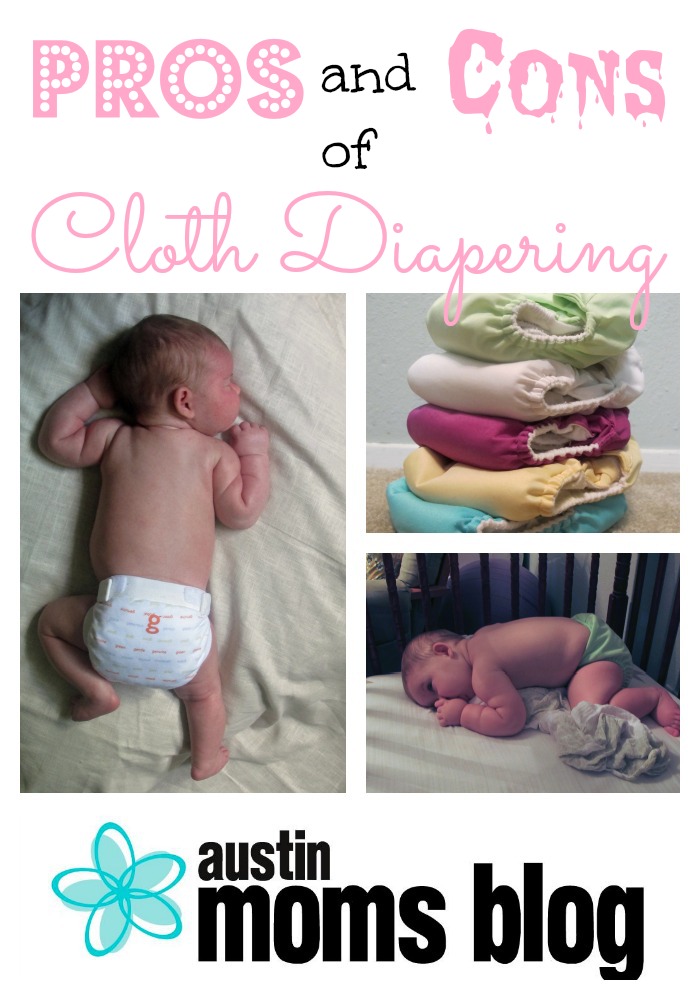Babies need diapers. There is really no way around it, unless of course you are in the camp that practices Elimination Communication, in which case I applaud your ability to predict your baby’s cues. For the other 99% of us who prefer not to clean up pee and poop all day, diapers are the answer. Simple, right?
As it turns out, just like everything related to babies, diapers are as far from being “simple” as I am from being an astronaut. As much as you’d like to say “I choose diapers,” and be done with it, at some point you’ll have to make decisions. The ultimate decision when it comes to diapers is whether to use disposables or reusables (aka cloth diapers).
As you might remember from one of my earlier posts about leaky diapers, this mama chose to go with cloth, and I’ll give you three reasons why:
1. CHEAPER. Yes, you read that right. The average baby goes through a minimum 8 diapers in a day (changing every 3 hours). That is not even counting the first few weeks when the little angels are flying through diapers quicker than you can say “meconium.” On average, you’ll spend anywhere from $600 -$800 A YEAR on disposable diapers, and babies are in diapers for the good part of 2 years.
Let’s compare that to what you might spend on cloth diapers. My husband and I chose to invest in several different types of cloth diapers: cotton prefolds and covers from Greenmountaindiapers.com, BumGenius All-In-Ones, and gDiapers. Here is what we’ve spent on diapers:
12 cotton prefolds = $40
5 covers for prefolds = $60
gDiapers newborn set = $150
6 gDiapers small shells = $75
6 gDiapers medium shells = $75
24 gDiapers cloth liners = $120
15 BumGenius AIO diapers = $300
Large wet bag = $20
2 small travel wet bags = $25
TOTAL INVESTMENT: $865
Keep in mind that we now have those diapers to use and reuse until Harlow is potty trained and then again with any future children. That $865 is a one-time cost. And if you choose a more minimalist route, you can get even cheaper. Here is what it would look like if you chose to use only cotton prefold diapers from my favorite diaper resource, Greenmountaindiapers.com:
36 cotton prefolds = $120
10 covers = $120
Large wet bag = $20
Two small wet bags = $25
TOTAL INVESTMENT = $285
2. NO DIAPER RASH. We have used cloth diapers all day every day since Harlow was 3 weeks old (see note above about meconium – I wasn’t about to do all that laundry after I just gave birth). She has not had diaper rash once. I honestly don’t even know what diaper rash looks like. We have only used bottom balm a handful of times when she had reflux that caused her to have more acidic poops.
3. LESS WASTE. Well, there is certainly plenty of the other type of waste, if you know what I mean…but there are no diapers to throw away because they are all reusable. That means fewer trips to take out the trash and more importantly, fewer diapers piling up in the landfill. You’ve heard how long it takes a disposable diaper to degrade in a landfill, right? Basically, it doesn’t. Just stop for a second and think about how many babies there are in the world and how many diapers they will go through and then picture those diapers in a huge pile in a landfill somewhere thousands of years from now. Gross. With cloth diapers, you are not contributing to the buildup of solid waste (other than what comes out of the baby, of course), and that is something to feel good about, especially if you use cloth wipes, too.
But I am not completely oblivious to the downsides of cloth diapering. Alas, there are some disadvantages to clothing your baby’s bottom.
1. LAUNDRY. You may not be taking the trash out quite as often as you would with disposables but you will be doing a lot more laundry. Most experienced cloth-diaper-users will tell you to wash your diapers every three days. This is to avoid the build up of smells (we’re talking about dirty diapers in a pail, after all), and to maximize your investment. You could theoretically buy enough cloth diapers to last you a week, but it is cheaper to buy a 3-4 day supply and do an extra load of laundry or two. This was certainly an adjustment for us considering we barely do our own laundry on a bi-weekly basis but now that I’m in the habit of tossing the diapers in every three days, it has become part of the routine and I barely notice the change.
2. WATER CONSUMPTION. Of course, all that laundry adds up to some serious water usage. This is where it is certainly advantageous to have a High Efficiency washer, but we happen to be stuck with whatever our apartment give us. We did see a slight spike in our monthly water bill (about $10-15 a month), but I’m less concerned about the financial cost than I am about the environmental impact. The trade-off of not having diapers in the landfill is using up one of our natural resources: water. And as we know all too well in central Texas, water can be a precious resource. However, I’m unconvinced that the impact of cloth diapers is equal to that of disposables, particularly if you take into account the environmental costs of producing and distributing disposable diapers. You can easily find cloth diapers that are made with organic, renewable materials, and they only have to be produced and shipped one time. To save on energy, you can pre-soak diapers to reduce the wash cycles and hang them to dry in the sun (which also helps remove stains) instead of running them through the dryer.
3. UPFRONT COST. Perhaps I already overcame this argument above, but it is worth noting that cloth diapers require an upfront investment. With disposables, you can buy diapers as you need them. With cloth diapers, for the most part, you’ve got to buy all the diapers right at the start. That means you are spending a large chunk of money at once instead of smaller amounts spread out over several months. Hopefully you can get some of your diapers as gifts as a baby shower, but either way keep in mind that with cloth diapers, you are investing in a long-term diapering solution that could potentially last you through several children. I personally intend to use the same diapers for all of our future children, which will end up saving us hundreds of dollars.
There are many more points that could be made for and against the use of cloth diapers and Allison’s blogged about it before, too. There is no lack of information on the subject floating around the Internet, either. But ultimately it’s up to you to find the best fit for your own family’s needs. If you don’t have easy access to a washing machine, cloth diapers are pretty much out of the question. If your baby has sensitive skin irritated by the chemicals in disposables, you might stick with cloth simply for that reason. The arguments above are what convinced us that cloth diapers were right for are family, and I’m so glad we made that choice.
What are your thoughts on cloth diapers? Do you prefer cloth over disposable diapers? Why or why not?
Oh, and did you read about Vanessa and Allison’s hilarious experience at the Great Cloth Diaper Challenge of 2012?












Hi, I am Evelyn! We’re so happy to hear that you think our products are great. You can find pictures by visit https://www.honest.com/about-us/testimonials or by clicking the links directly in the post above. You can also download each checklist for future use. Let us know if we can help with anything else!